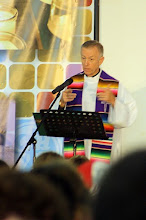Today’s meditation in Magnificat comes from British author Caryll Houselander. In part she writes:
From the universe we learn that God is infinite… From such things as insects, little frogs, mice, and flowers, we learn that to us he is something else. He is Father, brother, child, and friend!
If you ever had a little green tree frog and watched him puffing out with a pomposity worthy of a dragon before croaking, you must have guessed that there is a tender smile on our heavenly Father’s face, that he likes to laugh and he laughs with us; the frog will teach your heart more than all the books of theology in the world.
This is the kind of theology we all need to learn. Beyond this, if God laughs with us, would it not be wonderful if (this is the insight of writer Gerald May) we might actually make some choices in life that would cause our heavenly Father to smile, to laugh, to say "Way to go—I love it!"
It is in the little things that we best discover God, and it is in those things that we best respond to and honor God. St. Therese (the ‘Little Flower’) knew this with her ‘Little Way.’ St. Ignatius knew this when his Spiritual Exercises were designed to lead folks to ‘find God in all things.’ It’s where we can best (if we are open) confront, contemplate and experience the mystery of creation. William Blake put it like this:
To see a World in a Grain of Sand
And a Heaven in a Wild Flower,
Hold Infinity in the palm of your hand
And Eternity in an hour.
Understanding the small and seeing the connections leads us to affirm the greatness of life, as the story of the man in the Middle Ages, a stonemason, who was asked what he was doing. Others gave answers like “I am pouring lead for stained glass,” or “I am making arches,” or “I am designing a floor mosaic.” He simply said, “I am building a cathedral.”
The mystery here is a mystery of beauty and order—to see a complex mathematical series represented in the curvature of a seashell; to marvel at the idea that no two snowflakes are exactly alike in design (or, for that matter, no two fingerprints); to celebrate the fact that mathematical equations of our own creation can actually describe the rhythm and movement of the universe; to think that light broken down gives us the joy of color, while light ‘gathered together’ and focused gives us the power and intensity of lasers; to think that a wafer and sip of wine are the Body and Blood of our Savior, the price and vehicle of our redemption.
God is truly in the details (as God is, everywhere else as well). What a joy it is to be open to the discovery and to recognize the divine Voice in the crash of the surf or the whispers and songs of a forest after dusk; to see that glorious paintbrush in the sunrises and sunsets (or thunderstorms) of our days; to perceive God’s hand and pen in the pages of a prayer-book.
The Master of the Universe is also our playmate. Can our minds ever get around such a concept?
Subscribe to:
Post Comments (Atom)

No comments:
Post a Comment